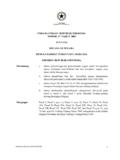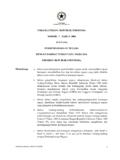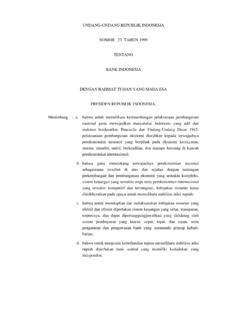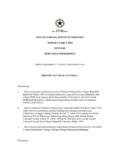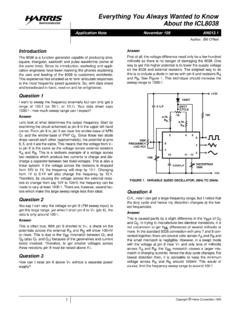Transcription of Student Alternative Conceptions in Chemistry - …
1 Student Alternative Conceptions in Chemistry (Originally: Student Misconceptions and Preconceptions in Chemistry ) Christopher Horton Worcester, MA 01602 with other members of the Modeling Instruction in High School Chemistry Action Research Teams at Arizona State University: June 2001, August 2002 and August 2004 Chemical equations .. it took me ages to pick it up as I found it quite confusing .. but having been taught by a teacher one way I tend to relate to it in the same way but in my own thinking .. in an exam I would probably get it wrong. You see when we are told to swot for a test we have to go swot in our book all the stuff the teacher s way .. we go home and we try to learn that .. but as soon as it hits our eyes it goes in our brain and it goes out the other way .. and so when we come to write it down and we think .. and we write it down all our way .. because of course it still means the same thing.
2 There is no difference .. but to the teacher there is a distinct difference between our way and the teacher s way .. and the teacher s way is the right way .. that s what I find so hard. 15-year-old science pupil in New Zealand, in Osborne and Freyberg (1985). Learning is an active process, and what students do with facts and ideas with which they have been presented depends to a very high degree on what they already think and believe. Being able to recognize and work with these Student -held ideas and Conceptions is thus a key component of an effective educational strategy. Mulford and Robinson (2002) expressed the problem thus: Alternative Conceptions play a larger role in learning Chemistry than simply producing inadequate explanations to questions. students either consciously or subconsciously construct their concepts as explanations for the behavior, properties or theories they experience.
3 They believe most of these explanations are correct because these explanations make sense in terms of their understanding of the behavior of the world around them. Consequently if students encounter new information that contradicts their Alternative Conceptions it may be difficult for them to accept the new information because it seems wrong. The anomalies do not fit their expectations. Under these conditions the new information may .. be ignored, rejected, disbelieved, deemed irrelevant to the current issue, held for consideration at a later time, reinterpreted in light of the Student s current theories, or accepted [while only making] minor changes in the Student s [previously held] concept. Occasionally anomalous information could be accepted and the alternate conception revised. If anomalous new information is presented in a learning situation where the Student is rewarded (with grades) for remembering it, the information may be memorized in order to earn the reward, but it is likely to be quickly forgotten because it does not make sense.
4 2 Table of Contents Foreword 1 Table of Contents 2 Introduction 4 Discussion Alternative Conceptions the problem: 6 Nature and origins of Alternative Conceptions in Chemistry 7 The search for key or central Alternative Conceptions 11 Implications for teaching. 13 Organizing the common Chemistry Alternative Conceptions 14 Rating the Alternative Conceptions 15 Recommendations 16 Acknowledgments 18 Table 1: Key or Central Misconceptions: The Expert Observers Selection 19 Table 2: Key or Central Misconceptions: a Classroom Teachers Selection 23 Appendix 1: Online Resources 25 Appendix 2: The Alternative Conceptions in Detail with Notes 27 Key 29 A. Essential Physical Concepts 29 : Size, displacement. 29 : Solid, liquid, matter, substance 29 : Air, gas, pressure (see also , Thermodynamics of gasses) 31 : Mass and weight: 31 Displacement and buoyancy, surface tension 32 : Heat 33 Nature of heat Heat capacity Insulation and conductivity Temperature 35 Molecular model of heat 36 : Force (limited inventory) 37 : Energy (limited inventory) 38 : Electricity (limited inventory) 40 : Electrical charge Electrical force Electrical potential Electrical current and circuits Batteries and cells B.
5 Basic Chemistry 42 3 Atoms (See also : Atomic structure) 42 Molecules 43 Atomic scale and Stoichiometry 44 Phase changes 45 Dissolution, solutions, precipitation 47 Chemical reactions 48 What is a chemical reaction? What causes a chemical reaction? Conservation of matter in reactions Energy in chemical reactions (See also : Energy) Reaction dynamics. Reversibility of chemical reactions Chemical equilibrium Combustion 54 Acid-base reactions 55 Oxidation, reduction and oxidation states 56 C: Electrochemistry (See also : Electricity) 56 Electric cells and batteries general 56 Electric current in electrolytes 56 Galvanic cells 57 Electrolytic cells 57 (Appendix 2, Outline of Topics, Cont.)
6 D: Thermodynamics 58 ( Heat: See : Heat) ( Temperature: See : Temperature) ( Molecular model of heat: see Molecular model of heat) First law of thermodynamics 58 Second law of thermodynamics, entropy and equilibrium 60 What is entropy? Entropy change in processes Determinants of equilibrium Driving force Spontaneous change and Gibbs free energy. 61 E. Atomic Structure and the Chemical Bond 62 Atomic structure (See also : Atoms) 62 Atomic shell and electron cloud models. 62 Atomic structure: electrical force 62 The nature of the chemical bond 63 Chemical bonds: ionic 63 Chemical bonds: covalent 64 Inter-molecular bonds. 65 Appendix 3: References 67 4 Contact Information 78 Introduction There has been controversy over whether to refer to Student Conceptions that aren t in accord with those held by scientists as "preconceptions" or "misconceptions".
7 "Misconceptions" seems excessively judgmental in view of the tentative nature of science and the fact that many of these Conceptions have been useful to the students in the past. "Preconceptions" glosses over the fact that many of these Conceptions arise during the course of instruction. Use of the expression " Student Alternative Conceptions " was finally agreed upon. The following review of the literature on Student Alternative Conceptions in Chemistry , and the compilation that came from it, was begun by participants in the Summer, 2001 Integrated Chemistry and Physics course at Arizona State University, who, on their own initiative, organized an action research team to begin the design of a new Chemistry curriculum. Work on it continued during the 2002 and 2004 summer meetings of the Modeling Instruction in Chemistry action research teams and their consultants. The Modeling Instruction in Chemistry action research team members were largely high school teachers who had been influenced by the Modeling Instruction in Physics workshops (Wells, et al.)
8 , 1995). The Modeling Method of Physics Instruction (described at ) focuses on scientific models as central units of knowledge. The original modeling program, for first-semester physics, was motivated by the role that major Student Alternative Conceptions play in blocking understanding of Newtonian mechanics. The program uses a patient guided-inquiry approach to leading students into confrontations with the results of experiment, getting them to articulate their thinking, and managing the Student discourse as they argue their way to a new interpretation. Dramatically higher levels of success have been achieved in this phase of physics instruction. A key feature of this program is use of research-validated concept tests such as the Force Concept Inventory (Hestenes et al., 1992) to measure Student conceptual change during the course of instruction. In recent years, high school, college and university teachers involved with modeling instruction in physics have been working to apply these insights and methods to other content areas of physics ( Swackhamer, 2001), to AP physics instruction, to middle school and high school physical science instruction, and now to Chemistry instruction.
9 Among the purposes for studying and cataloging Student Alternative Conceptions in Chemistry as part of a project to design a new curriculum were the following: 1. Identifying key misconceptions can help in designing curriculum, by identifying where Student breakthroughs are needed and alerting designers to pitfalls. Key misconceptions are those which, if left unresolved, have the potential to block or impede further progress. 2. Teachers and curriculum designers need to be aware that instruction can actually foster misconceptions that are later problematic and difficult or impossible to erase. This knowledge may lead to different choices in how initially to teach topics. 5 3. Understanding Student Conceptions is essential for designing effective questions and distracters for concept evaluation instruments and tests in Chemistry and physical science ( Yeo et al. (2001).) 4. An awareness of Student Alternative Conceptions provides teachers with a window into their students ' thinking, helping them listen to their students more powerfully, and thereby helping them to more skillfully manage Student discourse.
10 5. We sought to provide teachers, curriculum designers and researchers with a broad bibliography of Student Alternative Conceptions for further research. 6. The process of compiling Student Alternative Conceptions served as a stimulus to discussions about what Conceptions and models we most want our students to master, and how to frame them. If it is true and we believe it is - that students must construct their own understanding, and must build new understanding out of the Conceptions that they already possess, then it is inescapable that students will need to draw on their Alternative Conceptions for pieces that they can rearrange and reuse to form new concepts. Identifying the concepts the students possess contributes to the search for bridging concepts. These are concepts initially accepted by students which are close enough to scientifically accepted ideas to be useful in transitioning to the use of the latter, as proposed by Clement (1982) and de Vos (1987).
